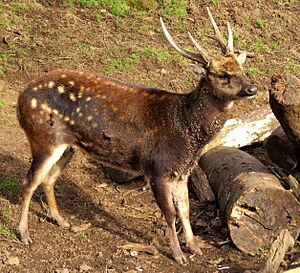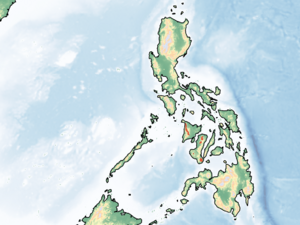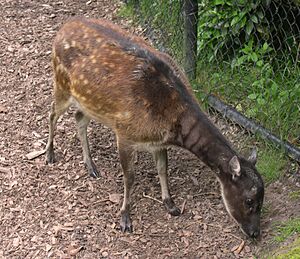Visayan spotted deer facts for kids
Quick facts for kids Visayan spotted deer |
|
|---|---|
 |
|
| At the Edinburgh Zoo, Edinburgh, Scotland | |
| Conservation status | |
| Scientific classification | |
| Genus: |
Rusa
|
| Species: |
alfredi
|
 |
|
| Synonyms | |
|
Cervus alfredi Sclater, 1870 |
|
The Visayan spotted deer (Rusa alfredi) is also known as the Visayan deer or Philippine spotted deer. This small, endangered deer mostly comes out at night. It lives in the rainforests of the Visayan Islands, especially Panay and Negros. It used to live on other islands too, like Cebu and Leyte.
This deer is one of three deer species found only in the Philippines. Scientists didn't recognize it as a separate species until 1983. In 1996, experts thought only about 2,500 of these deer were left. Today, the exact number in the wild is not known. These deer eat different kinds of grasses, leaves, and buds from the forest. Their diet tells us a lot about where they live. Since 1991, the areas where these deer live have become much smaller.
In 2009, a team of British and Filipino explorers found signs of the deer in the North Negros Natural Park. They found deer droppings and places where the deer had eaten. This was the first scientific proof of the deer's activity in over 25 years. It's thought that about 300 deer live on Negros Island. People are working to protect these deer, but they need more help and money. In 2012, camera traps took the first photos of the deer in the wild in North Negros Natural Park.
Contents
What Does the Visayan Spotted Deer Look Like?
The Visayan spotted deer is small and has short legs. But it is the biggest deer species found only in the Philippine islands. Adult deer are about 125 to 130 centimeters (49 to 51 inches) long from head to tail. They stand about 70 to 80 centimeters (28 to 31 inches) tall at the shoulder. They weigh between 40 to 60 kilograms (88 to 132 pounds).
You can easily tell this deer apart from other deer in the Philippines. It has special "A"-shaped beige spots on its deep brown back and sides. Its belly is cream-colored, and it has white fur on its chin and lower lip. The deer's head and neck are brown, but lighter than its body. Its eyes have lighter fur around them. Male deer are bigger than females. They also have short, thick, bumpy antlers.
Where the Visayan Spotted Deer Lives
This deer used to live from the shoreline up to about 2,000 meters (6,560 feet) above sea level. It lives in thick grasslands and forests. Most of its home has lots of young grass shoots, leaves, and buds for it to eat. They also like places where they can graze. Sometimes, they visit forest clearings that have been burned, to eat the ash. Because the deer's home range is now very small, it's hard to know exactly where they prefer to live.
Life Cycle of the Visayan Spotted Deer
The Visayan spotted deer usually breeds from November to December. However, mating might start earlier. Male deer make a loud roaring sound to attract females. Most reports say that a mated pair has only one baby deer. But it's hard to be sure because these deer are so rare. Baby deer are born after about 240 days. They stop drinking milk at six months old. They become adults when they are about 12 months old.
Protecting the Visayan Spotted Deer
Philippine law fully protects the Visayan spotted deer. Hunting and clearing forests have caused a huge drop in the number of these deer. People cut down trees for wood and to make farms. In 1991, a survey found the deer in only 5% of the areas where it used to live.
Even with these problems, the deer still live in some remote areas. These include protected places like Mt. Canlaon National Park and the North Negros Forest Reserve. In 1990, the Philippine Spotted Deer Conservation Program started to help save the species. Some deer are kept in zoos and special centers, like the Mari-it Conservation Centre in Panay.
Since 1987, Silliman University has been breeding these deer in captivity. Their program has been very successful. Some of the deer born in captivity have been released into the forests of southern Negros.
Why the Visayan Spotted Deer is in Danger
Cutting down forests is a big reason why the deer's numbers have dropped. Hunting also hurts the deer. Locals hunt them for food, and some people hunt them for sport. Selling deer meat in markets and restaurants, and catching live deer for pets, have all made the number of deer go down.
Because there are so few deer left in the wild (at least 300, down from almost 1,600), experts worry about their future. The IUCN Red List has listed the Visayan spotted deer as an endangered species since 1996.
Rediscovery of the Deer
In April 2009, a team of scientists found footprints and droppings of the deer. They found them in the North Negros Natural Park. The team included British, Filipino, and Irish scientists. They were studying the different kinds of plants and animals in the park. The team thinks fewer than 300 of these deer are left.
Three days into their trip, the team found footprints next to a river. Three days later, they found half-eaten young palm trees. The distance between these finds suggested that two groups of deer might live in the park. Later, the team found small piles of deer droppings. They were sure these belonged to the deer because other animals like the Visayan warty pig and civet have different droppings. This was the first proof of wild deer living there in over ten years!
The team was very excited. One of the leaders, Craig Turner, said, "this discovery confirms [the deer] are surviving, but doesn't tell us they are thriving." Besides the deer, the team also found rare plants like ground orchids and pitcher plants. They also found many bird and frog species.
The discovery was featured on the front page of the Philippine Daily Inquirer newspaper in May 2009. The British Ambassador called the find "an exciting discovery." The scientists said that the deer and other endangered species in the park need "more protection" to survive. They also said that "Philippine forests still harbor many rare and unique species, found nowhere else in the world."
In 2013, people reported seeing the deer in the Southern Candoni region. This suggests that the deer released by Silliman University in Basay have successfully moved north.
See also
- Philippine brown deer (C. mariannus)
- Calamian hog deer (Axis calamianensis)




